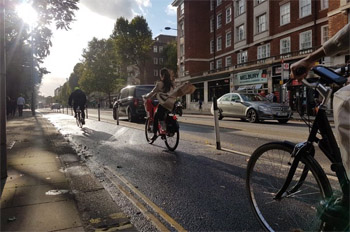Senior councillors in a London borough are to meet without the relevant lead member to discuss the possible reinstatement of controversial cycle lanes.
The Royal Borough of Kensington and Chelsea installed the temporary cycle lanes on Kensington High Street last year at a cost of £700,000 before removing them seven weeks later.
Earlier this month, London mayor Sadiq Khan called on the council to re-install the cycle lanes after publishing research suggesting that a majority of local residents supported them.

Picture @willnorman, October 2020
On Wednesday the council’s leadership team will consider a report that provides four options: installing temporary cycle lanes in full or installing parts of temporary cycle lanes; or not installing cycle lanes, with or without an option to consider an alternative scheme in the longer term.
The issue will be discussed in the absence of Cllr Johnny Thalassites, lead member for environment, planning and place, who ordered the cycle lanes to be removed.
A council spokesperson said: 'We know the depth of feeling on both sides of the debate surrounding cycling on Kensington High Street. That’s why the council leader asked to look again at the decision to remove the cycle lane and officers have prepared a report with the most up-to-date views, data and four options for consideration.'
The report notes that the scheme was not implemented until 14 October, when the second wave of the pandemic was just developing. It comments: ‘Plainly and with hindsight, the scheme was not implemented in a timely manner in respect of the waves of the pandemic.’
The report notes that there has not been a formal consultation on the scheme, ‘neither prior to its original implementation nor since’.
It adds: ‘Nonetheless, the scheme has elicited considerable comment and observation.’
The report also states that ‘both the London Ambulance Service and London Fire Brigade (LFB) raised concerns about the scheme and noted that their vehicles would not use the cycle lanes’.
An analysis of technical and other data in the report notes that: ‘Traffic schemes are generally put in place for at least six months.
'This scheme was in place for seven weeks and therefore the technical data we have been able to collect is does not itself provide a basis upon which firm conclusions can be drawn.’
Rachel Aldred, professor of transport at the University of Westminster, has carried out research into the impact of low traffic neighbourhoods and cycle lanes. She told Highways such interventions should be given at least six months to bed in.
The report adds that the weekend daily average ‘was not much lower than the weekday daily average, which is very different from typical pre-pandemic patterns’.
‘This suggests that there was a substantial amount of leisure cycling while the cycle lanes were in place.’
In relation to complaints that the cycle lanes caused congestion, the report observes that ‘the most noticeable increase in congestion came in the weeks of 26 October (half-term) and 2 November, which coincided with the start of several disruptive roadworks that changed traffic movements on Kensington High Street significantly’.
It adds: ‘In the week of 2 November, it is possible a pre-lockdown increase in traffic movements across London played a part in the extremely high levels of congestion observed over two or three days.’
The report states: ‘The data the Council holds in relation to air quality whilst the cycle lanes were in place is inconclusive.’
Register now for full access
Register just once to get unrestricted, real-time coverage of the issues and challenges facing UK transport and highways engineers.
Full website content includes the latest news, exclusive commentary from leading industry figures and detailed topical analysis of the highways, transportation, environment and place-shaping sectors.
Use the link below to register your details for full, free access.
Already a registered? Login